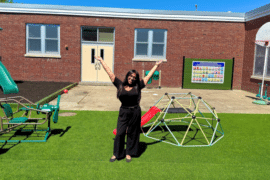Mindfulness in the Classroom: A Practical Guide to Getting Started
Mindfulness. It’s a word that seems to be getting tossed around a lot lately and is an extremely useful tool, but what is it exactly? What does it mean for you? What does it mean for your students? And the even bigger question – how do you implement it in your classroom? I have used it in my own classroom for years and have seen incredible positive changes in student focus, behavior and confidence.
What is Mindfulness?
Mindfulness is most easily defined as being aware of your thoughts, surroundings and physical self in the present moment without judgement. It means putting our to-do-lists and “what’s next?” thoughts to the side and actually living in the present moment. In a world full of distractions and practically constant stimulation, this can be particularly difficult for us to accomplish. Clearing our minds of the daily junk is a tall task, but once given the proper tools, this will be a life changing practice for you and your students. Mindfulness can help reduce stress, anxiety and destructive negative thoughts. There are many aspects and practices to mindfulness, so we will touch on a few of my personal favorites.
The Mindful Teacher
As teachers, we are flooded with a barrage of thoughts: concerns for students, ideas for our classrooms, creative ways to make our curriculum more engaging, wondering… “is someone coming to observe me today?”… just to name a few. Often, these thoughts can be daunting to sort through, let alone easy to put aside in order to just be present. This thought parade starts from the moment we wake up, carries through the rushed morning, into our commute to school and that’s all before even getting into the classroom!
Practicing Mindfulness
So, what do you do? Here are five simple steps to help get you there.
1. Just Breathe: You might hear the term “mindful breathing” and think – I don’t know how to do that! But, it’s simple. Just breathe. Sit yourself still for a moment and breathe. As you inhale through your nose, your mind is triggered to relax and be calm.
Start simply with ten breaths. Think of nothing but the air moving in and out as you inhale and exhale. You can use it multiple times a day in small moments like this. Starting your day with this mindful breathing practice will guide you through your day in a more mindful way.
2. Concentrate: Sounds easy enough, right? Well, it is. As you are taking those 10 breaths concentrate only on your breathing. Focus on how it moves through your body. Pay attention to what is happening to your body as you breathe. You may notice your chest or stomach is rising and falling with each breath. There is no wrong way to do this. Your mind may begin to wander and that’s okay. As you notice this happening, bring yourself back to your breath.
3. Awareness: Throughout your day, pay attention to routine activities. Notice the sights, sounds, smells and sensations of things which you normally do on autopilot: walking through the hallways, making photocopies, washing your hands, heating up your lunch, or just pouring a coffee. By doing this, you may find that being more engaged in these routine moments adds a bit more life and connection into your day, rather than moving through the motions mindlessly.
4. Listen Up: So often, when people are speaking to us, we think we are listening, but really we aren’t fully listening. We hear what the other person is saying, but while they are talking, our minds are busy thinking about a million other things from the day, or the day before or what’s next on our schedule. Instead, try to really hone in and listen to their words. It’s amazing what this act of mindfulness, this simple connection, will make you feel.
5. Baby Steps: Be patient with yourself and remember this is a practice. Mindfulness is best done in small bursts throughout the day, not in huge chunks.
The Mindful Classroom-Mindful Breathing
What does this mean for your students? Start with incorporating some mindful breathing into your classroom routine and be consistent. Anxiety and stress is building in our students and these small acts of mindful breathing can help enormously.
When?
Any time of day that works for your classroom is great! You can start a lesson by simply taking a moment to take some calming breaths. I did this with my class at many different points throughout the day, but a constant was always after lunch. This was a naturally relaxing time for their bodies anyway, so when we returned to the classroom, we worked on our breathing. If you are in the middle of a lesson and notice they are in need of a break, stop, breathe for a few breaths and you’ve gained some refocus. You’ll know what’s best for your class.
Who?
Students of any age can practice mindful breathing. The length of time will vary depending on age, but all students are capable and will reap the benefits.
How?
Make it fun! There are so many fun ways to do this and students can practice their mindful breathing while sitting or standing.
Kids can pretend a balloon is in their belly and imagine it getting bigger and smaller with their breath; imagine holding a big, beautiful flower and smelling that flower as they take deep breaths; imagine they are a bear hibernating for the winter and take long, deep breaths in and out, like the bear would; or trace the outline of the fingers on their hand with one finger from the other hand, inhale at the top of each finger and exhale at the bottom between fingers until they’ve done their entire hand. You can even play around and make up your own as you become more comfortable with it. The possibilities are endless.
Tools
You don’t need any tools for these activities, but if you’re interested in adding something to your classroom, a great visual to teach students about breathing is a breathing ball (Hoberman Sphere). You can find these online easily if you just search “Hoberman Sphere” or “breathing ball.” I got mine here. They are fun to look at and play with, so will immediately gain students attention no matter what their age. It starts out small and as you pull it open it expands to a much larger size. This helps students understand their breath and you can use this to guide them through their breathing. Inhale as it expands and exhale as it collapses back down. It can also be interactive, so students can take turns guiding the breathing themselves while holding the ball.
One of my favorite resources for more ideas on breathing is www.mindfulnessmonthforkids.com. You can sign up to get daily emails with new ideas on how to use breathing techniques with kids.
Students will become accustomed to this addition to your routine and begin to look forward to their mindful breathing breaks throughout the day. The best part of this is that it doesn’t take much time at all, so it can be done anytime and anywhere. When students start to ask for these breaks, you know you’re getting somewhere good and you’re well on your way to a mindful classroom!
Meghan Smerillo is a veteran elementary education teacher who lives in Point Pleasant, NJ. She has several years experience teaching in an inclusion classroom and bringing yoga/mindfulness to her students.





